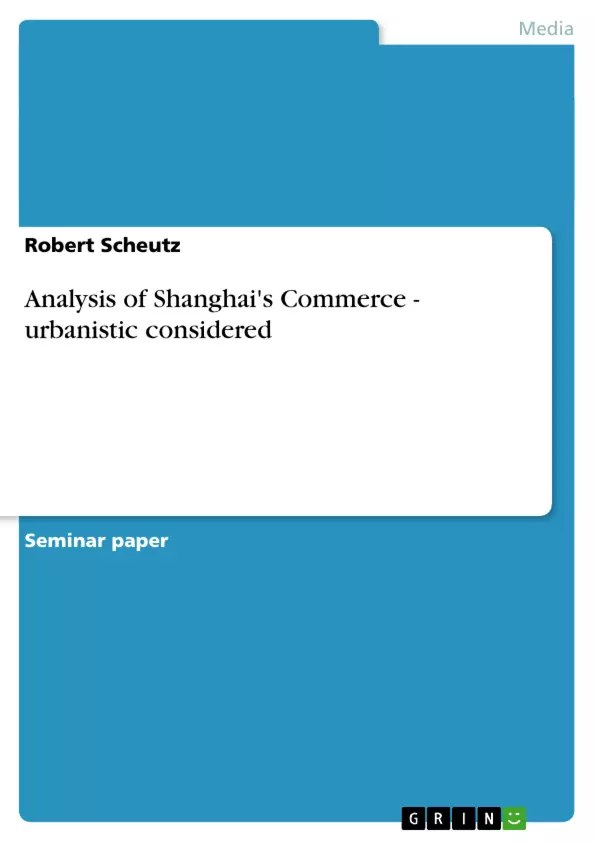The Yangtze River Delta, Shanghai-Nanjing-Hangzhou is undergoing a radical upheaval
process – the dimension and the speed of Shanghai's development exceeds European
thinking.
Between 1978 and 1990 about €3 billion were spent on urban infrastructure projects, in the
next six years between 1991 and 1997 the investment exceeded €18 billion. In the early
eighties the construction of the whole public mass transport system started from scratch,
following the strategic neglecting by the Central Government in Beijing. Today, after the
reforms of Deng Xiaoping and Jiang Zemin, a former mayor of Shanghai, it is said that the
city's large construction projects are the PRC Government's 'cuddles'.
2002 about 80 urban infrastructure projects with an investment of €6,5 billion were under
construction, supporting →AIR TRAFFIC →RAIL TRAFFIC →ROAD TRAFFIC and →SHIPPING.
In my opinion the rapid changes in the transport infrastructure will change more than the
map of the city or the mere building reality – it will change the city's timescale.
Firstly I want to focus on the meaning of the transport issue for China's and Shanghai's
economy and competitiveness. Shanghai has a great potential, but today it lacks fluency.
The PRC Central Government, with it's rising conscious of China's global role, has realized this
fact. The new economic and political ambition has overcome stone-age Maoism of bleeding
white 'decadent' cities - Pudong New Area with China's stock exchange in Luijazui
demonstrates this ambition.
The strategic position on the China Sea and the estuary of the Yangtze River enables
Shanghai to function as East Asia's main gate, both for domestic and supranational trade.
The current deep water port and dredging projects combined with new road and rail
connections to the rest of the PRC and its neighbours create the 'right flow' for growing, like
the comparison of the GDP and the container throughput shows.
However China's new economic 'XIAHAI' policy (promoting entrepreneurship) separates
severely from the governments restrictive social control, leading to the next issue – mobility
und urbanization. On the one hand the improvement of the mass transport infrastructure like
the extension of six further metro lines until 2005 increases the local mobility. Today Shanghai is
characterized by a high dense core and a low density outside core, such as the comparison
with London shows. [...]
Inhaltsverzeichnis (Table of Contents)
- 00 INTRODUCTION - dimension and speed
- 01 SHANGHAI BASICS - density and growth
Zielsetzung und Themenschwerpunkte (Objectives and Key Themes)
This paper aims to analyze the basic transport system of Shanghai and its impact on urban development patterns, particularly in the context of the Pudong New Area. It examines the rapid pace of infrastructure development in Shanghai and its relationship to China's economic ambitions.
- The rapid development of Shanghai's transport infrastructure and its impact on the city's timescale
- The relationship between transport infrastructure and China's economic and political ambitions
- The role of transport infrastructure in shaping the urban structure of Shanghai
- The challenges and opportunities presented by motorization and urbanization
Zusammenfassung der Kapitel (Chapter Summaries)
- 00 INTRODUCTION - dimension and speed: This chapter outlines the radical upheaval process that Shanghai is undergoing, highlighting the city's extraordinary growth rate and the scale of infrastructure projects. The chapter uses comparisons with European cities to emphasize the unique scale and speed of Shanghai's development. It also notes that Shanghai has one of the fastest growing metro systems in the world.
- 01 SHANGHAI BASICS - density and growth: This chapter focuses on the demographic and economic characteristics of Shanghai, comparing its density and growth to that of London. It discusses the urban structure of Shanghai, noting the high density of the core and low density of the outskirts, which it attributes to the former neglect of the transport system. The chapter also explores the impact of the new infrastructure measures on the urbanization of Shanghai.
Schlüsselwörter (Keywords)
Key terms and concepts in this text include: transport infrastructure, urban development, Pudong New Area, China's economic ambition, motorization, urbanization, urban structure, density, Shanghai, China, and global role.
- Quote paper
- Robert Scheutz (Author), 2003, Analysis of Shanghai's Commerce - urbanistic considered, Munich, GRIN Verlag, https://www.grin.com/document/24944



